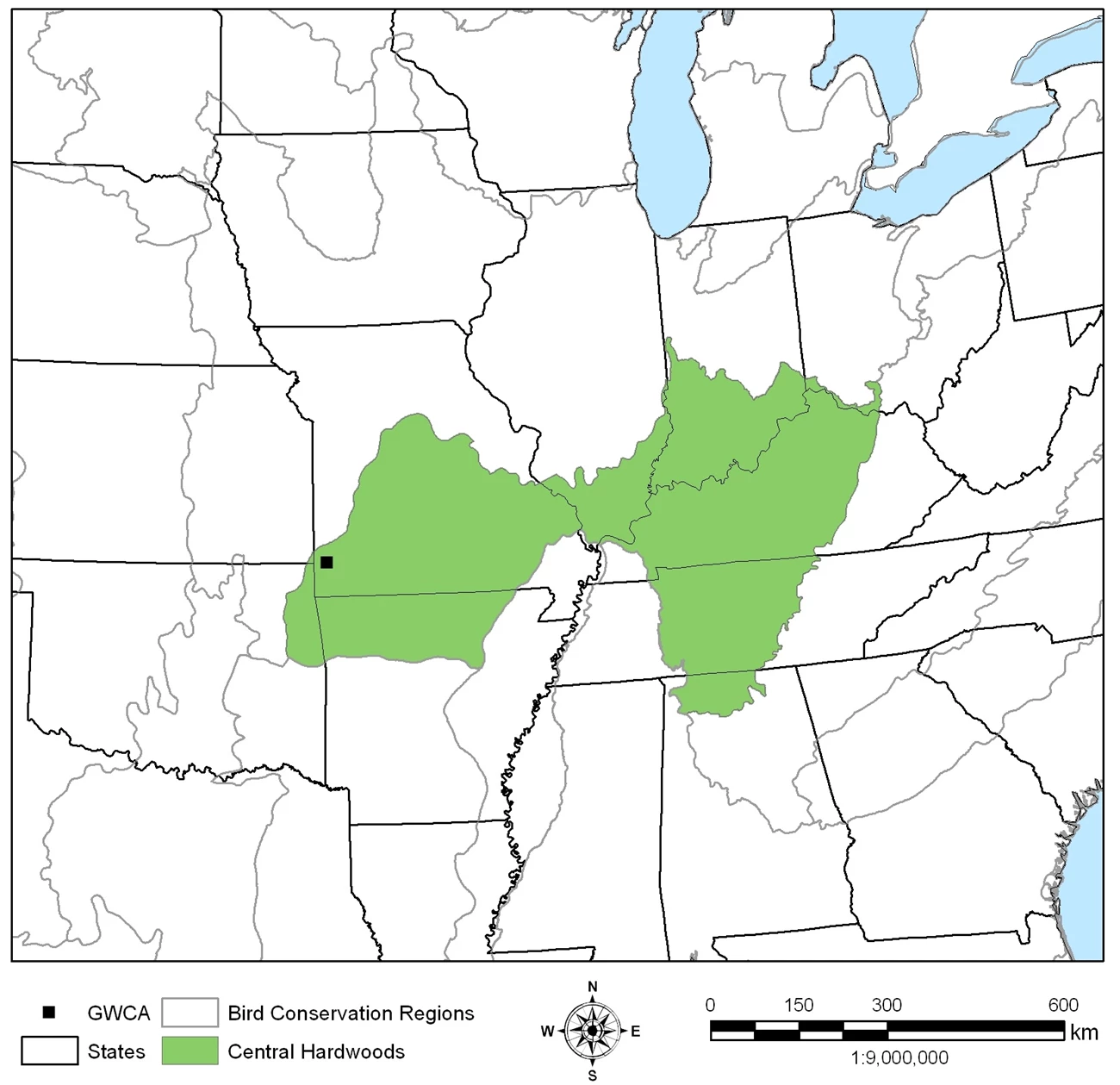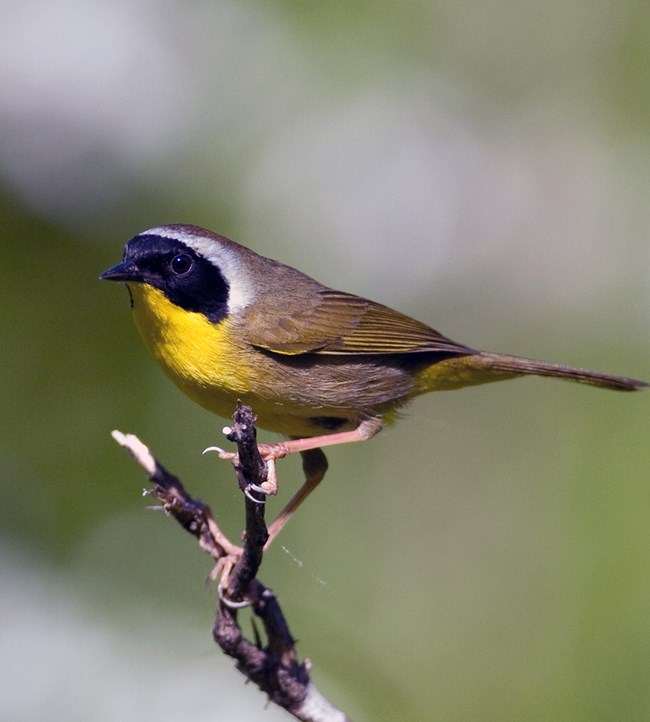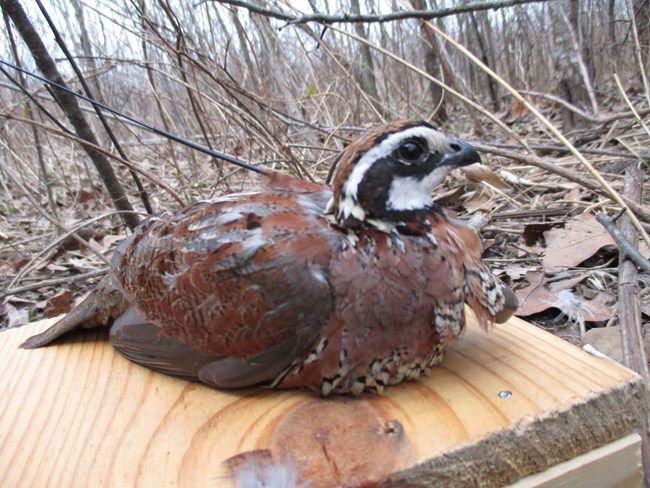Last updated: June 21, 2024
Article
Bird Community Monitoring at George Washington Carver National Monument, 2020

NPS/Jane Gamble
Why Do We Monitor Birds?
Birds are an important part of the world we live in. They eat pests, disperse seeds, pollinate plants, and feed us, and birdwatching is a multi-billion-dollar industry. Park interpretive programs often feature birds because of the enjoyment they provide. Birds are also great indicators of environmental change. They serve as the canary in the coal mine for an ecosystem—an early warning system for environmental change.
The landscape in and around George Washington Carver National Monument contains a rich mix of forested plant communities and grasslands. About 111 breeding bird species are found here. Widespread habitat loss to agriculture and urban and industrial development threaten bird habitat in the region around the park. Unfortunately, 28% of the birds that breed on the park are in decline in the region and some birds, like the Barn Swallow, Belted Kingfisher, Carolina Wren, Cedar Waxwing, Chimney Swift, Eastern Bluebird, Grasshopper Sparrow, House Sparrow, Loggerhead Shrike, and Northern Bobwhite are declining at alarming rates.
Scientists in the Heartland Inventory and Monitoring Network measure changes in birds and their habitat to determine the health of bird communities and park ecosystems. During the breeding season, we survey birds at George Washington Carver National Monument and gather information about the structure and composition of the park plant communities that birds live in. We also compare park bird trends to bird trends in the larger region. Together, these data help researchers determine how bird populations are faring and how birds respond to changes in their habitat. Knowing how birds are doing can help the park take effective steps to restore and maintain the park's beautiful landscapes.
Bird Monitoring Highlights (2008–2020)

NPS
Park Bird Community
We started surveying birds at the park in 2008 and have found 100 different bird species in 13 years of surveys. Ninety-seven of these species have the potential to breed within the park; two species are classified as transients in the area; and one species is a winter resident. Nine of the breeding birds are grassland species, 36 are eastern forest species, and the rest are more habitat generalist or edge species favored by the mix of forest and grassland habitats on the park.
The number of bird species found during surveys decreased over time in park grasslands and woodlands. On average, we found 37 bird species in the grasslands and 29 bird species in the woodlands annually, but over the years the number of species decreased from 45 to 30 in grasslands and from 34 to 20 in woodland habitats. The way that birds were distributed across the landscape was relatively unchanged over the years. Six breeding species on the park are considered species of conservation concern for the Central Hardwoods Bird Conservation Region, the region in which the park is located.
| Common Name | Scientific Name | AOU Code | Park Resident? |
| Bell's Vireo | Vireo bellii | BEVI | summer resident |
| Cerulean Warbler | Setophaga cerulea | CEWA | summer resident |
| Henslow's Sparrow | Ammodramus henslowii | HESP | summer resident |
| Kentucky Warbler | Geothlypis formosa | KEWA | summer resident |
| Loggerhead Shrike | Lanius ludovicianus | LOSH | year-round resident |
| Red-headed Woodpecker | Melanerpes erythrocephalus | RHWO | year-round resident |
Bird Habitat
George Washington Carver National Monument in Missouri is located in the western edge of the Ozark Highland section of the Central Hardwoods Bird Conservation Region. This section, commonly referred to as oak savanna, historically consisted of the transition zone between the northern and western tallgrass prairie and southern and eastern pine-hardwood forest.
The park has very structurally diverse vegetation communities, including abundant grasslands and some woodlands. This habitat diversity is especially important for the bird species of regional concern because their microhabitat requirements vary. Red-headed Woodpeckers prefer farmlands, open woodlands, orchards, and urban/suburban forest; Kentucky Warblers prefer moist deciduous bottomlands and ravines; Cerulean Warblers prefer mature trees near swampy areas and streams; and the other species of concern require thick shrubby or old field habitat. The declining number of bird species in the last 13 years in both the grasslands and woodlands suggests that park bird habitat is not meeting the requirements of some bird species.
We will continue to monitor birds and how they respond to changes in their environment to help the park manage habitat for birds. Conserving bird habitat preserves entire ecosystems for the benefit of all species.

NPS

NPS
Trends of Common Bird Species
Ten breeding species in grassland and six in woodland habitats had populations that were large enough for us to measure abundance (how many individuals there were). Knowing how many birds there are helps us examine trends in bird populations over time on the park. We can then compare park bird trends with trends in the larger Central Hardwoods Bird Conservation Region.
- Most of the common birds on the park had uncertain trends. This means that we did not see significant increases or decreases in their populations but we are not completely certain that their populations experienced changes of less than 5%. More surveys will help us determine population trends.
- The Northern Cardinal population in park woodland habitat was stable over time.
- The Eastern Meadowlark was in moderate decline and the Northern Bobwhite was in steep decline on the park.
Overall, common bird populations in the park are doing about the same as populations in the larger region with a few exceptions: Field Sparrow and Indigo Bunting in park grassland habitat and Carolina Wren in park woodland habitat had uncertain trends but declined significantly in the region. Red-bellied Woodpecker had uncertain trends in grasslands on the park but are increasing significantly in the region. This is not surprising since the trees that this species forages in are sparse in the abundant grassland habitat on the park.

NPS/Nolan Moore
Did You Know?
Eastern Meadowlark and Northern Bobwhite are experiencing declines in the region and even larger declines on the park. This suggests that the clump grasses, bare soil, and forbs (smaller flowering plants) that create the old-field habitat type they require may be disappearing from the park. In addition, woody shrubs, vines, and tree seedlings are increasing in the grasslands, providing perches for avian predators that may be negatively affecting meadowlark and quail populations. Promoting tallgrass prairie-open woodland habitats (also called oak savanna) on the park would meet the grassland requirements of these two species and many other species, including the Dickcissel and Grasshopper Sparrow. The sparse open woodland would also benefit Loggerhead Shrike and Red-headed Woodpecker, two other species that are declining at alarming rates in the region.
For More Information
Read the Full Report.Check back later for updates. We will update this page each year as we gather more information.
Visit the Heartland Inventory & Monitoring Network website.
